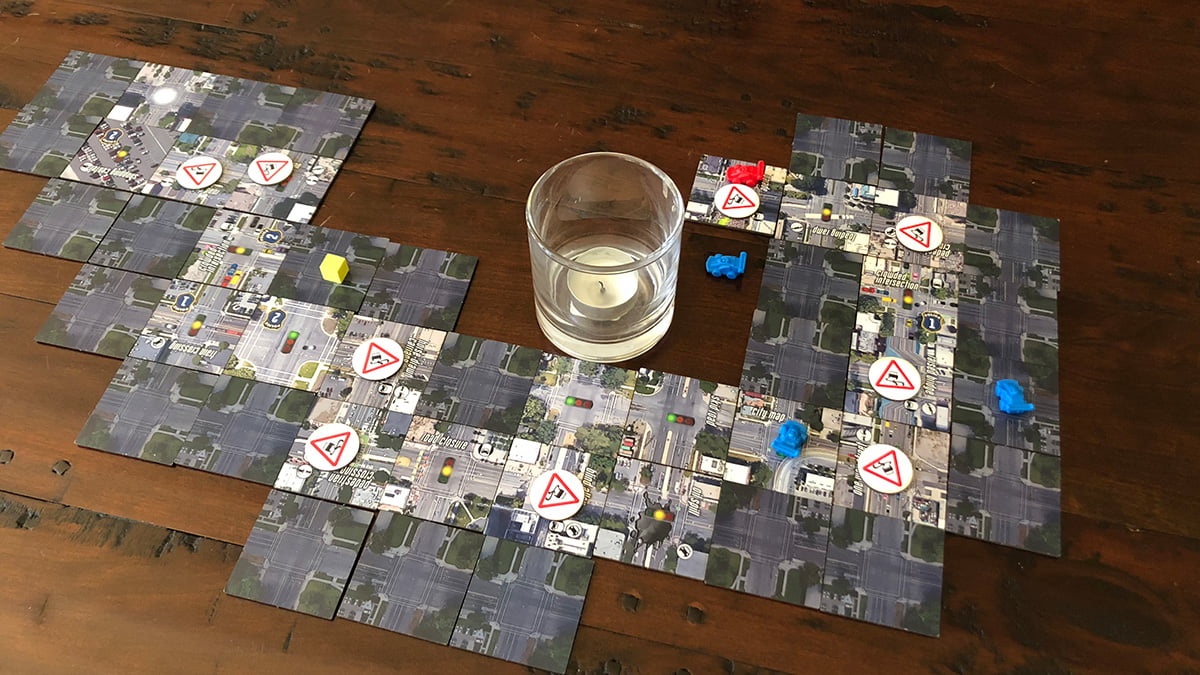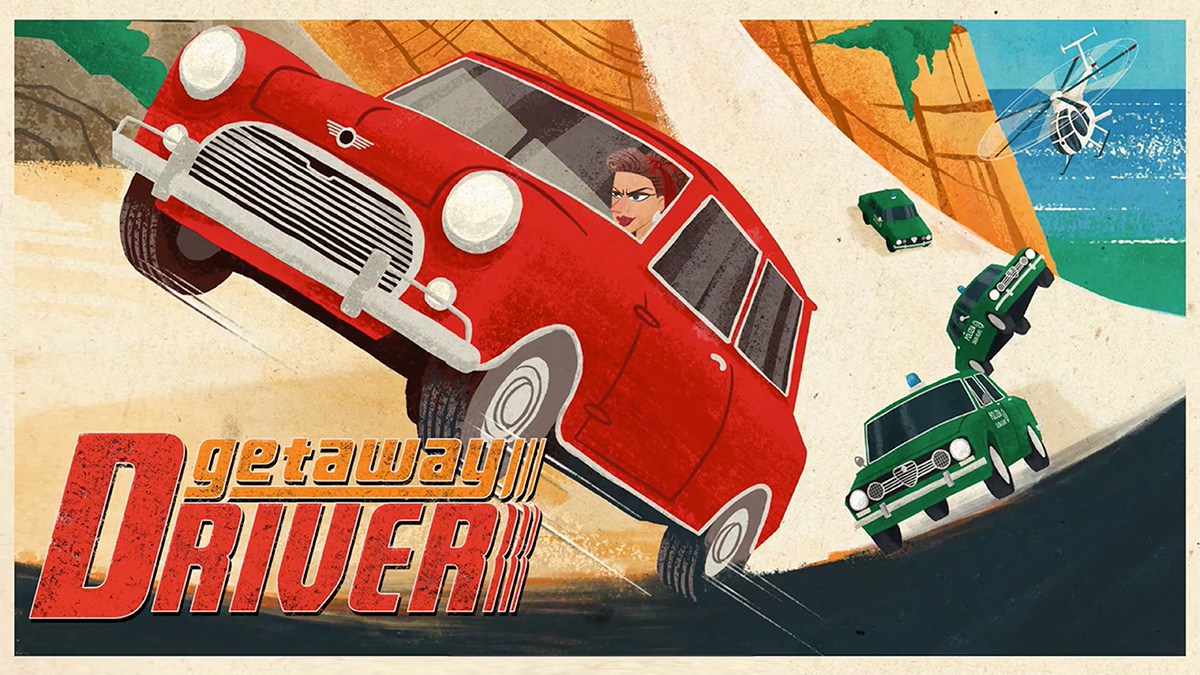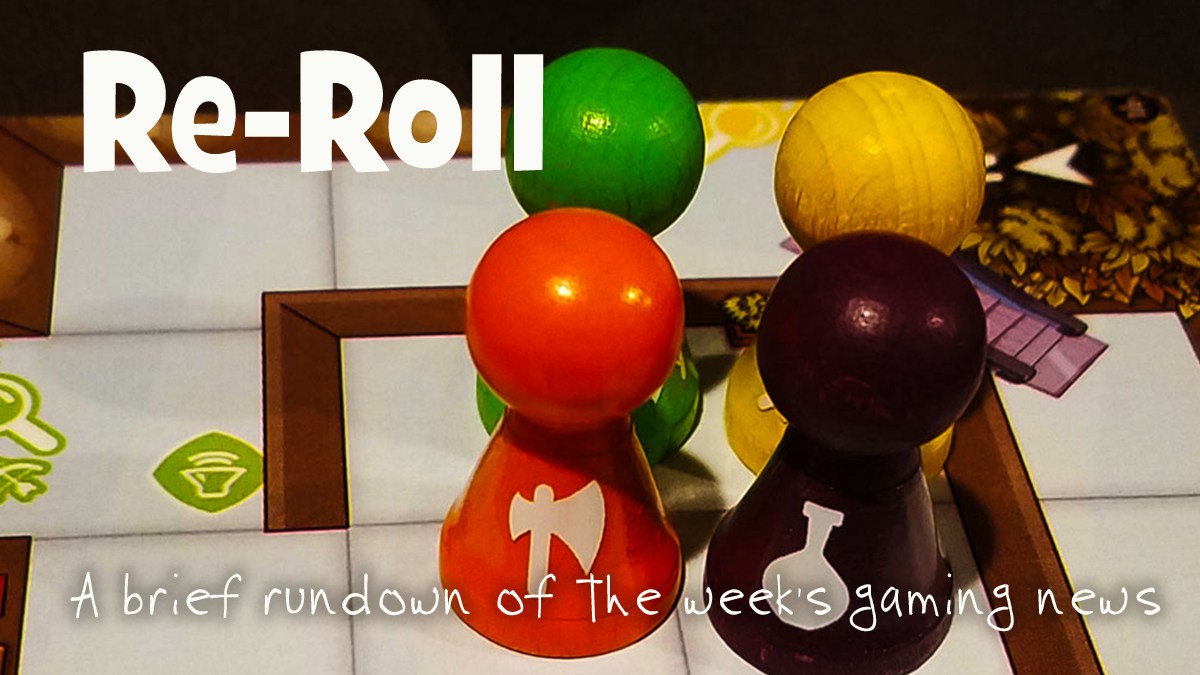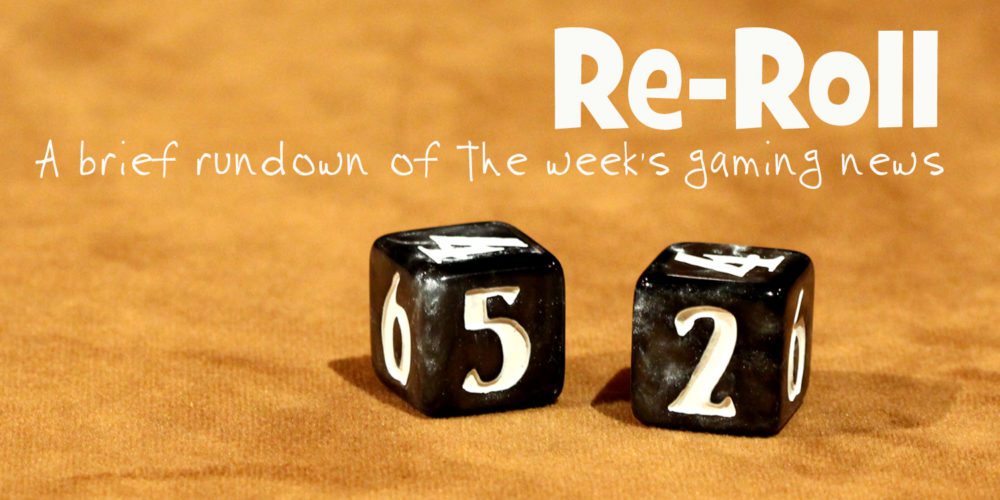Bullitt… Ronin… To Live and Die in L.A.… Hollywood knows there’s nothing like a great car chase to get people passionate. Car chases, after all, combine the strategic challenge of a chess match with the visceral excitement of screeching rubber and screaming V-8s. Throw in some wailing sirens and flashing lights and there is little that’s more breathtaking.
Now you can enjoy that same adventure at home with a new game that launches on Kickstarter today. Getaway Driver pits player against player in a calculating thriller that will have your heart pounding with a pace like you were Gene Hackman racing against a subway car.
What Is Getaway Driver?
Getaway Driver is an asymmetric two-player game of cat and mouse; it’s a Hollywood chase scene played out on cardboard. In the game, one player is a daredevil driver, pulling off stunts and doing whatever they can to get out of town. The other player is the police, trying to shut down the driver by any means necessary. The game is from Uproarious Games (Word Domination, read our review) and comes to Kickstarter today.
New to Kickstarter? Check out our crowdfunding primer, and visit our Kickstarter curated page for more projects we love.
Getaway Driver Components
Here’s what you can expect:
- 56 City tiles (1 starter tile, 15 green light tiles, 25 yellow light tiles, 15 red light tiles)
- 1 Drawstring bag
- 12 Hazard tokens
- 3 Police barricade tokens
- 1 Driver pursuit meter and a tracking token
- 10 Driver cards (dual-purpose, abilities and stunts)
- 7 Police upgrade cards
- 8 Stash cubes
- 10 Police enforcement cubes
- 1 Driver car
- 3 Police patrol cars
- 1 Police motorcycle
- 1 Police Armored car
- 1 Police helicopter
The version I played was an early prototype, so things will definitely be changing, but some bits seem to be pretty close to final. The tiles, for for one, look to have art that will be used in the final version. On one side is a dark, nighttime, top-down view of an intersection (all tiles are 90º, perfectly perpendicular intersections). Flip the tile over and there are photorealistic images that depict these traffic ways; some have been embellished with additional art like traffic jams or food trucks or people. I really like the artwork on these.
The cards, both for driver and police, seem to have the same backs that I played with and I really liked them. They give a good sense of the speed of this car chase. The police upgrade cards illustrate the upgrade with some text explaining how you can improve. It also includes the upgrade’s cost. The driver cards are multi-purpose with one side showing an ability and the other showing a stunt. They are laid out so you have to rotate them to read either side.
The rest of it is going to change, so I can’t comment on them much, other than to say that the Kickstarter project has some pretty awesome vehicle meeples (or vehiceeples) as stretch goals.
How to Play Getaway Driver
Setup
Roles are decided on, with each player getting their appropriate components. The driver gets a pursuit meter and marker, their car, a starter tile, and the 8 stash cubes, as well as a deck of driver cards, combinations of special abilities and stunts they can use to get out of a tight spot. They choose seven of these and set the others aside. The police get upgrade cards, barricade tokens, police cars, a motorcycle, an armored car, and a helicopter. The police enforcement cubes are placed nearby and the city tiles are placed in the draw bag and mixed up.
The driver tosses the stash cubes on the playing area. (Note: there is no truly defined area for playing Getaway Driver. If play runs up the edge of a table or into a book or vase or anything else, consider it part of the city and play around it.) The police then rearrange the stash cubes, making sure no cube is more than 6-8 inches away from any other and that none is closer than 2-3 inches from any other. With this complete, the driver chooses where to place the starting tile and places it on the table with the driver’s car on top of the tile.
The police place one of their patrol cars two spaces away from the driver on the starting tile. This can be two spaces away, horizontally or vertically, or one space horizontally and one vertically. Since there is no diagonal movement in Getaway Driver, these are all legal placements.

Gameplay
There are three phases of every round. First, the police place tiles, followed by the driver taking their actions, then the police and their actions. When placing tiles, the police draw three tiles from the bag and look at them secretly. In relation to the driver’s current position, the police must place a tile in front of, to the right, and to the left of the driver’s car. The tiles must be placed face-down and police only draw tiles equal to the number of empty spaces to the front, right, and left of the driver’s position.
A quick word on tiles: In addition to a description, there are three basic types of tiles, one for each color on a top light. Green light tiles are clear roads, which benefit the police and not the driver because hazard tokens may not be played on green light tiles. Yellow light tiles offer the driver some flexibility because they can choose whether or not to place hazards there (caused by the driver’s reckless driving). The police aren’t fond of yellow light tiles. Red light tiles require a hazard token. Some tiles show a police badge with a number. These represent where police have a patrol and, when they are flipped, the police receive enforcement cubes, which they can spend later. Finally, there are five special tiles that grant special abilities when flipped—everything from flipping extra tiles for free to removing an enforcement cube from the police’s supply.
The Driver’s Turn
On their turn, the driver has five optional actions. The first is the most important—moving, which has two parts to it. The driver car may be turned 90º and then moved a single tile in its current direction. The driver can move, then turn, only turn, or only move (or do nothing), but the turn cannot happen after being moved. If the driver moves, they must flip the city tile and deal with the outcome the tile presents.

When the tile flips, the driver must place hazard tiles if mandated by a red light or choose to if there’s a yellow light. If there is now a hazard token on the tile, the driver must play a stunt card from their hand. Yellow and red light tiles have icons showing which stunts can be performed to get through the tile—driving on the sidewalk, driving on two wheels, into oncoming traffic, or other stunt cards can get the driver safely through a hazard. However, now that stunt is in out of the driver’s hand.
Driver’s cards can be recovered with the next action, reclaiming a driver card. By visiting a tile that has a yellow stash cube on it, the driver claims that resource, which can be spent to reclaim a driver card from the discard pile. However, the stash cubes are limited, so the driver must be judicious about when to reclaim cards. Especially since the next optional action also affects the driver cards.
In addition to the stunts that will keep the driver ahead of the police, they also provide powerful abilities that can mean the difference between a getaway or police custody. With extra movement, police wreckage, e-brake turns that reverse your direction, and more, abilities are almost invaluable. But if you use one, you run the risk of not having a stunt to get past a hazard. It’s a true dilemma!
If the driver doesn’t possess a stunt card or have a stash cube to reclaim a card that will help, things begin to look desperate. They can either use the Clear the Road action, which allows them to remove a hazard token from a tile (but not do any other actions that turn) or back their car onto the tile from where they came from. This results in the police getting closer and the driver going nowhere that turn.
Lastly, the driver might want to be cautious in their movement. Before moving, the driver can flip over city tiles to reveal what is down the road. For each tile flip, the driver must advance the pursuit meter one space and, if the meter reaches the final space, the driver loses—even if the police are nowhere near the driver.
There are a lot of decisions for the driver to make and none of them are easy. So the strategy must be sound if the driver is going to get out of town—and that doesn’t even take 5-0 into account…
The Police’s Turn
Johnny Law has five actions each turn; two of them are optional. If any police vehicle is on the same tile as the driver on the last turn, it must follow the driver onto the new city tile. If a hazard tile has been placed there, the patrol car crashes out and returns to inventory. The police do a lot of good things, but they are not good at stunt driving, it seems.
Police vehicles that are not on the same tile as the driver can move as they wish, following the same movement rules as the driver. However, there are a couple of differences. Police vehicles do not reveal tiles when they move on to them. Police vehicles may not move onto tiles with a hazard token placed on them and must drive around them. They do have a movement advantage—police vehicles may move off tiles into the spaces surrounding placed tiles, however, they must be within one space of the tiles.
After moving, the police should check to see if they are tailing the driver, that is, on the same tile as the driver. If they are, move the pursuit meter up one space. (Conversely, if the police end their movement and the driver is alone, the pursuit meter drops one space.)
Next, the police may purchase an upgrade. Using enforcement cubes they’ve collected, the police may gain a special ability or bring more vehicles to the pursuit. Finally, the police may choose to forego all other actions and simply take an enforcement cube that turn.
The police don’t seem to have as many options as the driver, but the upgrades they have are powerful and they have numbers on their side.
Resolution
Game play continues until one of two conditions are satisfied. If the pursuit meter ever reaches its highest space, the driver is caught and the police win. If the police place the last tile from the draw bag, the driver has escaped the city and won.

Why You Should Play Getaway Driver
A chase brings out the most primal instincts in all of us—capture or get away, depending on your role. Whether it’s playing tag on the playground or a more civilized game like Getaway Driver, there’s a thrill in the chase. What’s more, since Getaway Driver is a two-player, it is more personal, a battle of wits and deception, of out-maneuvering your opponent. Getaway Driver presents an outstanding tête-à-tête that is fraught with tension. At the beginning of each game we played, it seemed like the driver had a huge advantage, but by the end of every game, the scales had tipped toward justice. On the side of the constabulary, it was an exercise in excitement, trying to guess which direction the driver was going to go when pursuing her law-breaking ways. And as the driver, it was nerve-wracking to commit to a direction and turn over the tile—especially toward the end of the game, when the stunt cards were drawing low.
For the driver, building a deck at the beginning of the game holds important decisions. You want to have a hand that includes at least one of each stunts so that you can get by hazards, but you also want to choose the best abilities. The intersection for those card types is difficult to parse. Then, once you built your hand, it’s a challenge to manage. Maybe you were holding back an ability to get you out of a pinch, but a red light hazard now forces you to discard your ace in the hole—or sit in place for a whole turn while Smokey draws ever closer. Stash cubes are an excellent way to get the card back, but making your way to retrieve them is a route riddled with risk. The police know that you want those cubes, so what tiles will they hide beneath them? Red lights to drain your cards? Or patrol tiles that reward the thin blue line with enforcement cubes? And then there’s your route. Since your goal is to deplete the police of tiles, it would make sense to always be headed toward the edge of the game area, forcing the police to place three tiles each turn, but a series of red lights could wipe out your deck and force you back toward the center of the city.
For the cops, the game is no easier. Throwing out red lights forces cards out of the driver’s hand, but they also create a whole string of tiles the police can’t cross or enter. Upgrade cards provide the overwhelming response you expect from the strong arm of the law, but in the spirit of fair gameplay, can also be taken out by a smart driver player. The police also have the most powerful piece in the game—the helicopter. It costs a lot of enforcement cubes to activate, but when you do, this pursuit vehicle is nearly impossible to evade. The police have force in numbers, but their vehicles are mostly fragile and easily taken out of the game. Drawing tiles is also an equalizer, but a smart police player stands a good chance of guessing a driver’s path and places the most advantageous tiles in that path.
The game is well-balanced and immensely enjoyable. Games move quickly enough that there is a lot of replayability as you try different strategies, swap roles, and eagerly seek out retribution. Sometimes, the game comes to a stop with one or both players not moving to take advantage of an action or see what the other player will do. It’s a sinfully good time. Getaway Driver is thick with theme, but if you want to complete the mood, pop on some music with a high tempo for your own frenetic soundtrack and you have the recipe for an awesome time.
Getaway Driver is seeking funding on Kickstarter beginning today.
![]() To subscribe to GeekDad’s tabletop gaming coverage, please copy this link and add it to your RSS reader.
To subscribe to GeekDad’s tabletop gaming coverage, please copy this link and add it to your RSS reader.
Click here to see all our tabletop game reviews.
Disclosure: GeekDad received a copy of this game for review purposes.






